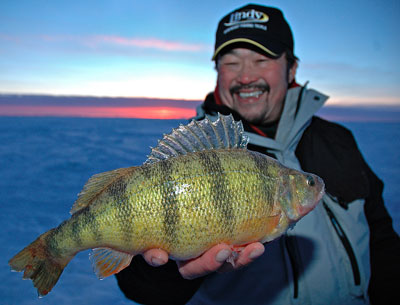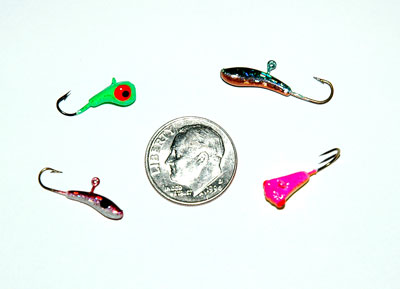Modern ice fishing methods have increased our enjoyment of the sport with advanced electronics, underwater cameras, and space age shelters/clothes which keep you warm. New tackle is also keeping anglers on the cutting edge. Rattles, high intensity glow colors and innovative shapes are catching more fish than ever before.
But as intense angling pressure is affecting many of our lakes, the fish are slowly adapting to more subtle presentations. That’s where ‘small ball’ fishing is taking shape. Small Ball fishing is downsizing your jigs, hooks, and bait. If the loud, flashy, and vigorous action is not working, then start going small.
Modern ice fishing methods have increased our enjoyment of the sport with advanced electronics, underwater cameras, and space age shelters/clothes which keep you warm. New tackle is also keeping anglers on the cutting edge. Rattles, high intensity glow colors and innovative shapes are catching more fish than ever before.
 But as intense angling pressure is affecting many of our lakes, the fish are slowly adapting to more subtle presentations. That’s where ‘small ball’ fishing is taking shape. Small Ball fishing is downsizing your jigs, hooks, and bait. If the loud, flashy, and vigorous action is not working, then start going small.
But as intense angling pressure is affecting many of our lakes, the fish are slowly adapting to more subtle presentations. That’s where ‘small ball’ fishing is taking shape. Small Ball fishing is downsizing your jigs, hooks, and bait. If the loud, flashy, and vigorous action is not working, then start going small.
In order to take advantage of this trend in smaller lures, Lindy has recently introduced some awesome new micro-sized, mini mites for the ice. All of these new jigs sport super small #12 and #14 sized hooks. The Lindy Toad, Bug, and micro Slick Jig are all sized right to entice small nibbles from all species of fish.
Location
First of all, your location is critical when fishing on the ice. Bottom structure that holds baitfish is best for walleyes and perch. Focus on drop-offs near points, on humps or channel edges. Crappies often suspend over the deepest water in small lakes. In larger lakes, they can be found suspended over the deepest areas of bays. Search funnel areas created where the tips of two points come close to each other or where a sunken island is located just off a point. Try fishing on the edges of old weedlines left over from the summer.
Good electronics are critical. Use a Humminbird ICE 55 to find the fish. Look for smaller clouds which could be forage fish, then adjust your location in the school until you see larger, individual marks that could be gamefish. Underwater cameras are also useful in determining the species of fish and how they react to your jigging action.
Rigging for jigging
Some of the new, high tech rods for ice fishing today are built specifically for jigging small, but ‘heavy’ jigs. That means a tiny hook, but heavier body. The St. Croix Legend ice rod, LIRML, is made with plenty of backbone and a fast tip. This rod is perfect for Small Ball jigging. Too often, ice anglers resort to wimpy sticks. Choose a rod that  balances with the size of jig and the weight of line you plan to use. The jig should be heavy enough to keep kinks from the line, and you should feel the jig bounce through the rod when everything is right.
balances with the size of jig and the weight of line you plan to use. The jig should be heavy enough to keep kinks from the line, and you should feel the jig bounce through the rod when everything is right.
Try jigging with a hand-held rod and choose the right-sized Thill float for your “dead” rod. There are a wide variety of Mini-Shy Bites or Mini-Stealth floats that can be perfectly paired with almost any size jig.
Use jigs with #10 to #14 sized hooks for eurolarvae, also known as "spikes." The larger, 1/8 and ¼ oz. Slick Jigs are perfect for minnows. Keep your bait fresh.
Set the depth of the floats so your jig sits just above the marks on the screen or the flasher. If multiple rods are allowed, try setting one real high in the water column just below the ice. There are times when all species of fish will suspend 2 to 3 feet beneath the hole. Any fish that close won’t show up on your electronics very easily.
With your hand-held rod, lower your jig into the hole just below the water. Jig it and watch how it behaves. If your jig is spinning, adjust it until it stops by moving your knot on the jig or re-hooking your bait. When ready, lower the bait into the water and start fishing it SLOWLY down into the "fish zone" using a jigging motion called “pounding”. This makes the jig appear more alive than just lowering it down fast. If the jig stops moving, set the hook. If you don’t get a bite, try tempering your jigging motion to a slight quiver.
Here's another tip. Watch your electronics closely. If most of the crappies are concentrated at one depth and you see a fish come into the sonar's cone at another depth, raise or lower your jig quickly to intercept it. Most likely it’s a bigger crappie than those in the main school.
Try some Small Ball ice fishing this winter with some of the new micro jigs from Lindy. You’ll be hooked on going small!










